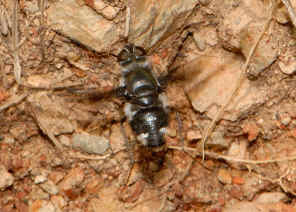|
| |
Family Bombyliidae
- This page contains pictures and information about Black Beeflies in Tribe
Anthracini Genus Thraxan that we found in
the Brisbane area, Queensland, Australia.
-
 -
- Beeflies in subfamily Anthracinae are commonly known as Black Beeflies. They have their wing vein Rs forks very close to
cross vein r-m. They are from small to medium
in size. Most of them are dark brown to black in colours, with black patterned on
hyaline wings. Most species have the white spots on abdomen.
-
- Black Beeflies are strong fliers, often found feeding on blossom, flying around dead or fire-blackened trees where mud wasps are building nests.
Some Black Beeflies species have the hill-topping habit.
-
- Anthracini larvae are parasites on larvae of other insects, including
wasps, flies, beetles, grasshoppers, lacewings, butterflies and moths. Females lay eggs near a potential host. The first instars is
free-living and will find the host within the ground or host nest. Later instars usually feed upon a single host. The pupa is armed with spines.
- Genus Thraxan is restricted to Australia. Thraxan species are very
similar with each others. To distinguished them reliably on photos is
difficult. On the abdomen there are always the distinct white or yellow dots
on middle of segment 2 and 3. They could be either T. depressus, T. simulatus, T. emicatus, T. caligneus, T. caligneus, T. patielus, T. cornuatus, T. hamulus, T. nodus, T. echinatus, T. spiculus, T. misatulus, T. acutus, T. prolatus,
or T. abditus.
-
- Genus Thraxan is recorded as parasitic upon Sphecidae
and Vespidae. There are
records of their emerged from the mud cell of Mud-Dauber
Wasp.
-
-
- Thraxan Beefly
I

  - Thraxan sp., body length 10mm, female, male
- Pictures were taken in Karawatha Forest during early summer. The fly was
resting on plants 0.2-0.3 meter above ground, seems waiting for something. It
was also found resting on rock and on floor. Abdomen segments 5-7 lateral margins
are with white hairs. The haltere
knob is dark brown with apical third cream. R2+3 meets r-m cross-vein
directly. Please also visit this page
for more details.
-
-
- Thraxan Beefly II
-



- Thraxan simulatus, body length 10mm, male, female
- Abdomen segments 5-7 lateral margins are with white hairs. The haltere
knob is dark brown in colours. We found this Black Bee Flies in
Carbrook Wetland and Anstead Forest. Please also visit this page
for more details.
-
-
- Thraxan Beefly III



- Thraxan sp., body length 10mm, female, male
- Pictures were taken in Anstead Forest o Feb 2010. Please also visit this page
for more details.
-
-
- Thraxan Beefly IV


 - Thraxan prolatus, body length 10mm, male
- Abdomen segments 5-7 lateral margins are with white hairs. Spur-vein at
base R2+3 present. We found this fly in Karawatha Forest on Feb 2007. Please also visit this
page
for more details.
-
-
- Thraxan Beefly V
 
 - Thraxan cinctus, body length 10mm, female
- Abdomen segments 2 posterior margin with transverse of white hairs.
Pictures were taken on Dec 2012 at White Rock. Please also visit this page
for more details.
-
-
- Thraxan Beefly VI


 - Thraxan obstipus, body length 10mm
- Picture was taken on Sep 2007. Abdomen segments 2 posterior margin are with transverse of white hairs. Please also visit this
page
for more details.
-
- Reference:
- 1. Insects
of Australia, CSIRO, Division of Entomology, Melbourne University
Press, 2nd Edition 1991, p 759.
- 2. Insects of Australia and New Zealand - R. J. Tillyard, Angus
& Robertson, Ltd, Sydney, 1926, p364.
- 3. Family
BOMBYLIIDAE - Australasian/Oceanian Diptera Catalog - Web Version, by
Greg Daniels.
- 4. Cryptic species diversity and character congruence: review of the tribe Anthracini (Diptera : Bombyliidae) in Australia - David K. Yeates and Christine L. Lambkin,
1998.
- 5. An evolutionary radiation of beeflies in semi-arid Australia: systematics of the Exoprosopini (Diptera: Bombyliidae) - Lambkin CL, Yeates DK & Greathead DJ, Invertebrate
Systematics, 2003.
[ Up ] [ Anthracini-Anthrax ] [ Anthracini-Thraxan ] [ Exoprosopini ] [ Villini ]
| |
|



















